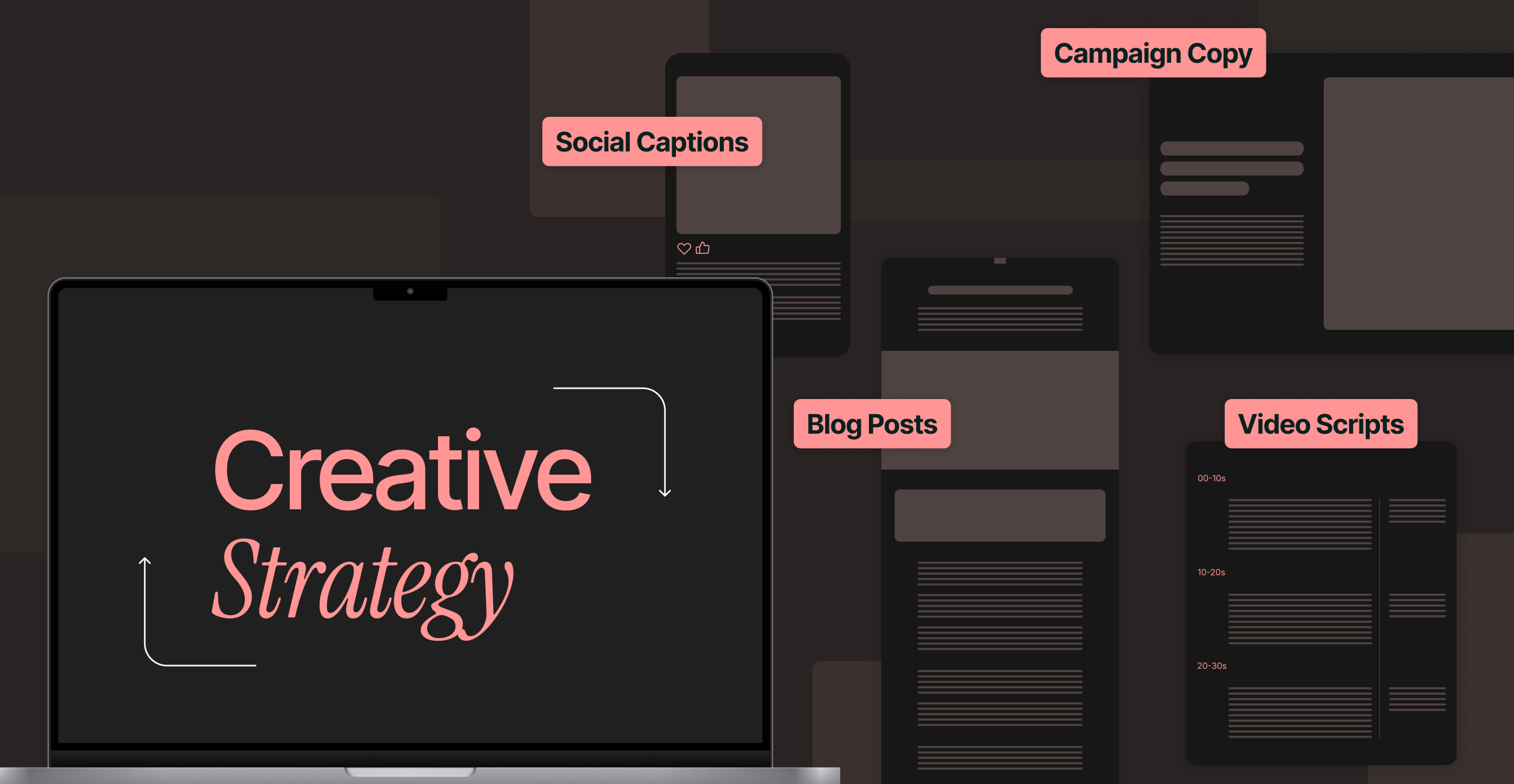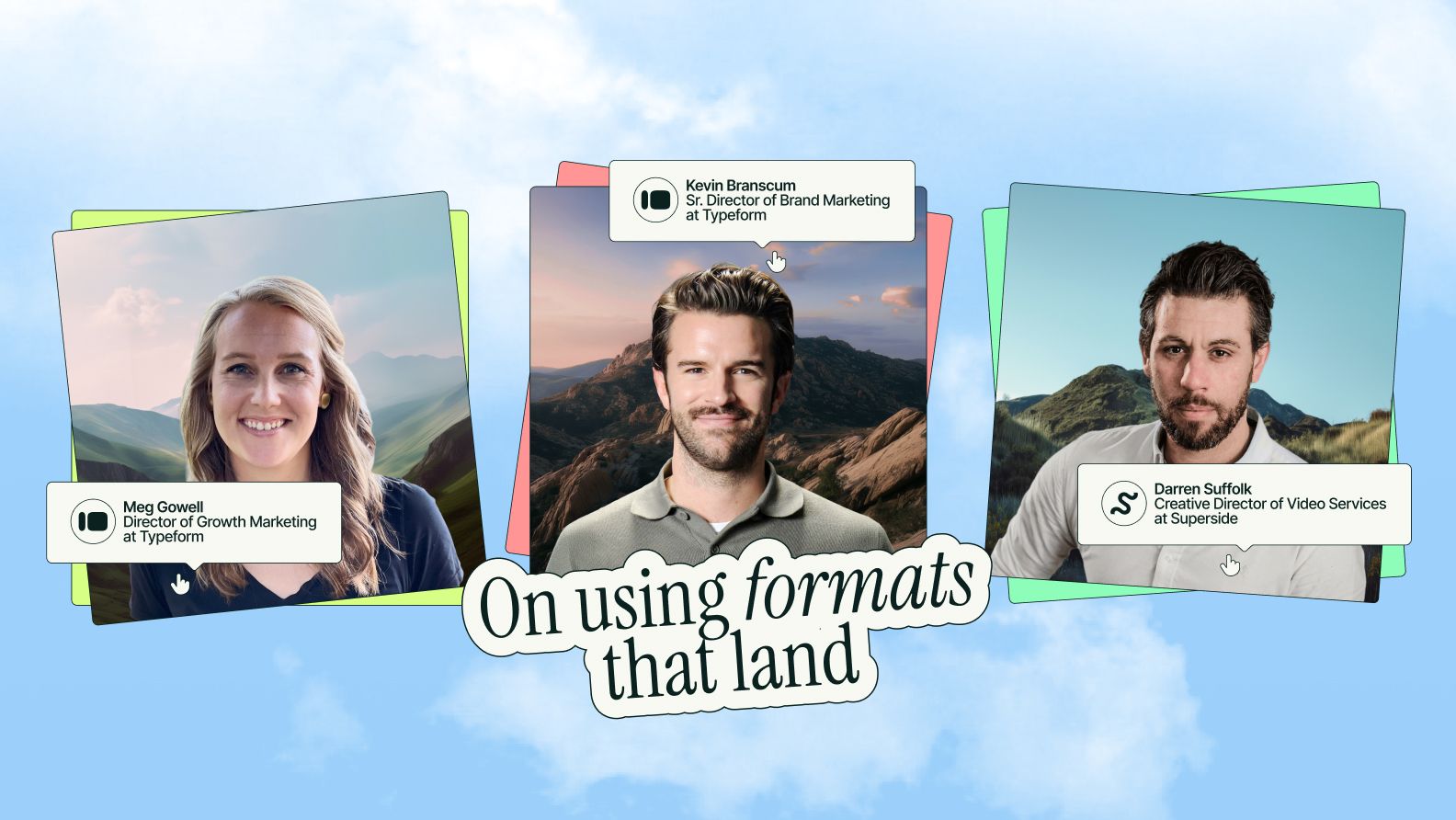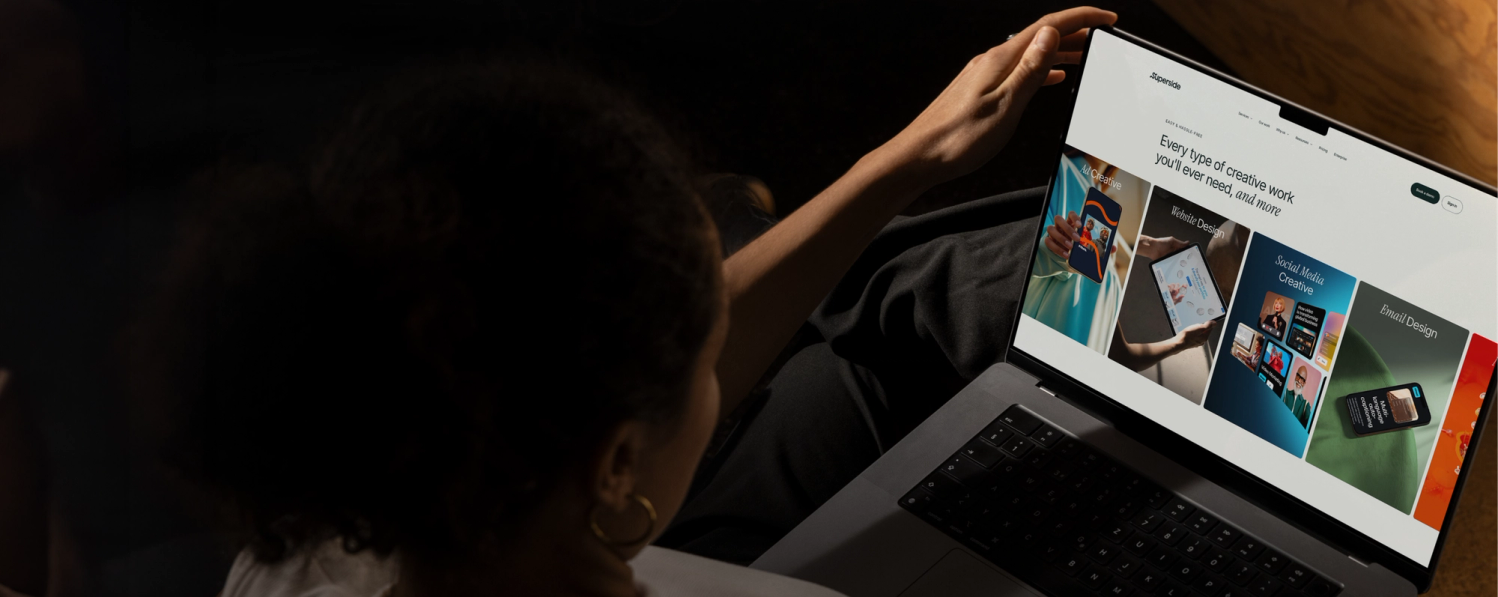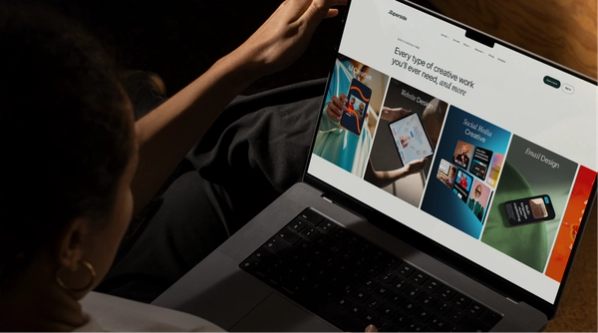14 content marketing examples from top brands to inspire your strategy

Today’s successful brands use personal, helpful and human-centered content to cultivate trust, brand loyalty and authentic connections. Captivating content must be creative and compelling, as our content marketing examples in this article illustrate.
Content marketing has evolved beyond blogs to include videos, podcasts, personalized emails, attention-grabbing social media posts, Large Language Models Optimization (LLMO) and much more.
Good content marketing works like a bomb, with 87% of marketers reporting it boosted brand awareness over the past year. Additionally, 82% of professionals say they’ve invested in content marketing as a core business approach.
The best enterprise marketing content is on-brand, connects creatively with target audiences, captures their attention, builds trust and drives engagement. A sharp, audience-first marketing strategy is the starting point.
Looking for standout content marketing examples to inspire your creative team? We’ve collected insights from leading enterprise brands on how to align creative branding strategies with practical execution.
If you get stuck, Superside can help you create standout ads and content-driven campaigns at speed—from concept to execution to results.
The 5 main content marketing types
Content marketing is evolving thanks to AI, interactive formats (think AR and VR) and changing digital marketing trends.
At its core, successful content marketing focuses on creating value for the target audience, rather than merely promoting or selling products or services. It also engages audiences where they naturally spend their time rather than overwhelming users on every available channel.
Let’s look at the most popular content marketing types and where to use them.
1. Social media content for brand engagement
Social media and content marketing go hand in hand. With 71% of consumers likely to recommend a brand after a positive experience on social media, it’s become an essential tool in every marketer’s toolkit.
Content-driven digital ad campaigns on social platforms also help companies reach new audiences. Over time, content published on social channels can also build brand loyalty and advocacy.
Goals:
- Build brand awareness with engaging content that resonates (aim to educate or entertain).
- Drive traffic to your owned platforms (e.g., your website, blog, or app).
- Start conversations that help you build long-term customer relationships.
- Use social commerce to increase sales.
Types of social media content:
- Short-form video—TikTok videos, Instagram Reels, YouTube Shorts, LinkedIn videos.
- Interactive stories and live formats—Instagram Stories, Facebook Live, YouTube Live, TikTok Live, LinkedIn Live.
- Thought leadership and brand POVs—LinkedIn posts, content published on third-party websites (e.g., Medium or Quora).
- Community engagement content—LinkedIn Groups, Discord servers, brand-owned communities.
- User-generated content (UGC)—Customer testimonials, TikTok challenges incorporating branded hashtags.
Best practices:
- Be quick: Social media moves fast. You have approximately three seconds to create an impression, so start with something impactful.
- Keep it authentic: Remain faithful to your brand’s personality and bring in real human faces and voices.
- Engage, don’t just post: Respond to comments, share others’ content and talk with your audience—not at them. They’ll notice.
- Invest in owned spaces: Platforms such as LinkedIn and Discord allow you to create lasting communities without depending on algorithms.
2. Blogs and thought leadership content
In 2025, creating original, valuable thought leadership content is essential. Note, however, that the content needs to serve both humans and search engines, rather than being focused solely on SEO.
Blogs and other forms of online articles (e.g., case studies and news stories) are among the oldest, most effective forms of content marketing. In 2025, it’s important to create in-depth articles that share expert insights, build trust and showcase what sets your brand apart.
In a world where AI-generated content is starting to dominate, original thinking stands out. Plus, Google’s new E-E-A-T algorithm places an increased focus on author expertise and experience.
Goals:
- Establish trust and enhance brand credibility by producing strong thought leadership-style content.
- Enhance search visibility through articles centered on search intent.
- Provide valuable insights that your audience would find truly useful.
- Drive customers down the sales funnel, educating them first and making your case for purchasing your product or service as they consume more of your content.
- Write well-structured articles that are optimized for LLMs.
Types of written content:
- Blog posts and in-depth articles that provide valuable insights.
- eBooks and whitepapers for in-depth exploration of topics.
- Case studies that demonstrate brand impact, rather than simply stating it.
- Reports and data-driven content that transform numbers into insights.
- Step-by-step guides that make complicated tasks feel achievable.
Best practices:
- Prioritize value: Every content piece should educate, entertain, resolve a problem, or present a new perspective.
- Write for people, optimize for search: Know what your audience is searching for; then ensure your content is SEO-friendly and easy to find.
- Make it visual: Use images, videos, page widgets, infographics and charts to enhance the content.
- Use AI wisely: It can speed things up, but your original voice and perspective matter most.
Top tip: Recycling and repurposing content is a cost-effective, time-saving solution for busy teams. Use your top blog posts as a foundation for content marketing. Break them into emails, create video scripts or extract snippets for social media posts. Also, make sure you regularly update these articles.
3. Video content marketing for brand storytelling
Video accounts for 82.5% of internet traffic, making it a powerful way to convey your brand’s story, showcase your products or services, and connect emotionally with your audience.
Video is where much of the magic happens for enterprises growing their content marketing footprint. Whether it’s a polished brand film or a quick TikTok story, good video production can help you convey your messages in a way text can’t.
Goals:
- Build brand awareness and increase engagement with compelling visual storytelling.
- Increase conversions with content that educates, inspires or solves target customers’ problems.
- Elevate your brand and position it as an industry leader by showcasing your leaders’ opinions.
Types of video content for brands:
- On-trend, branded video campaigns that create emotional connections.
- Product demos and explainer videos that make complex offerings easy to understand.
- Behind-the-scenes content showcasing the people and culture behind your brand.
- Customer testimonials and case studies demonstrating tangible results.
- Live-streamed Q&As, webinars and events to actively engage your community in real time.
Best practices:
- Customize content for different channels: Use short-form for TikTok, Instagram Reels and YouTube Shorts, and longer-form videos for your website and YouTube Channel.
- Prioritize quality: Clear audio, good lighting and careful editing are essential for making a strong impression in even the simplest videos.
- Incorporate user-generated content (UGC): Involve your audience in creating content. Authentic stories from real people build trust and connection. TikTok Challenges are a great way to start.
- Use AI-powered tools: Editing, captioning and voiceover automation tools simplify producing high-quality video content at scale.
4. Email marketing for customer connection
Email marketing has been around for decades but remains a powerful content marketing tool. After all, you have a captive audience and your email list is entirely yours. Before launching any campaign, make sure your list is healthy, email list cleaning helps you find email addresses of inactive or invalid contacts and remove them, which in turn ensures higher deliverability and engagement rates.
Approximately 4.5 billion people worldwide use email, with 88% checking their inboxes several times daily, making it one of the most effective ways to connect with your audience directly.
Goals:
- Convert interested customers over time. Use a drip campaign to take them on a journey from the awareness and interest phases of the sales funnel to where they take action and purchase your product or service.
- Strengthen customer loyalty and retention with valuable content.
- Deliver personalized, highly segmented or localized content and relevant offers.
Types of email content for brands:
- Regular newsletters featuring industry insights.
- Exclusive announcements and new product launches.
- Drip campaigns for educating and engaging leads.
- Event invitations and webinar promotions to drive sign-ups and engagement.
- Post-purchase follow-ups and re-engagement emails.
Best practices:
- Segmentation and personalization are key: Tailored emails outperform generic ones.
- Optimize for mobile: Most emails are read on phones. Keep them uncluttered, simple and easy to read.
- Use clear CTAs: From “Shop now” to “See more,” always make the next step obvious.
- Get spam savvy: With email security becoming stricter, ensure the emails you craft land in your subscribers’ inboxes.
5. Podcasts and audio content for in-depth discussions
Podcasts offer businesses a unique advantage: Uninterrupted attention. In a world of constant distraction, they allow for longer narratives and deeper insights, and can help brands nurture authentic connections.
Podcasts are an excellent choice for content marketing campaigns prioritizing substance over trivial topics.
Goals:
- Establish your brand as a trusted voice in your field.
- Share insightful, inspiring and valuable content.
- Engage new audiences beyond traditional marketing channels.
Types of branded audio content:
- Expert interviews on highly relevant topics.
- In-depth trend analyses.
- Stories that vividly illustrate your brand’s culture, values or mission.
- Educational episodes focusing on real-world challenges and answers to common questions.
Best practices:
- Prioritize audio quality: A clear audio experience enhances credibility and maintains listener engagement.
- Distribute widely: Broadcast your podcast across all major platforms, including Spotify, Apple and Amazon Music, using a tool like Acast.
- Cross-promote: Share episodes via your website, social media platforms and emails.
- Try live formats: Platforms like TikTok Live and YouTube Live foster real-time conversations and audience engagement.
Create podcast videos: More than 1 billion people a month view podcast content on YouTube.
14 inspiring content marketing examples
We’ve compiled a list of real-world content marketing examples to demonstrate the effectiveness of different content types.
1. Superside’s design-first newsletter
Superside’s newsletter, The Creative Brief, is aimed at content marketers and creatives, and offers concise insights and eye-catching visuals.
A lot of work goes into these newsletters, helping them to stand out from competitors’ efforts. “It’s packed to the brim with creative brilliance, marketing insights and humor,” one subscriber notes.
Why it works: The newsletter is fun, practical and engaging. It’s a content marketing example that shows how helpful content can help you build ongoing relationships (even advocacy) with your target audience.
Video content is everywhere, but to succeed on social media, your videos need to be highly educational or entertaining (both, if possible!). This video on why marketers must leverage video content is fun to watch. Plus, it’s packed with great advice.
Why it works: Superside merges content creation with a deep understanding of how the world currently consumes content. The result is an engaging social video that supports our comprehensive content marketing strategy.
Side note: Did you know Superside provides video production services? Our creatives are experts at customizing video for each platform, using data-driven insights and AI-enhanced creativity to deliver standout work.
From crafting campaign teasers to launching products via live streaming, we’ll help you tailor your video content to match each channel’s format perfectly.
3. Ryanair’s unhinged TikTok persona
Ryanair’s official TikTok channel is both entertaining and slightly chaotic. 😵💫They transform complaints into jokes, use trending sounds to grab your attention, and produce intentionally raw content.
The posts are witty, and some of the comments even funnier. It feels like an unfiltered friend manages the account, making it even more memorable.
Why it works: Ryanair embraces its no-frills identity with humor and speed, earning it sky-high engagement and a growing Gen Z following.
4. Duolingo’s bold, gamified content marketing strategy
(Source: Duolingo, TikTok)
Duolingo has turned language learning into a daily habit for millions. With its iconic green owl, captivating lessons and enjoyable push notifications, the platform encourages users to return regularly.
On TikTok, the brand showcases its personality through humorous skits and AI personas promoting Duolingo Max, the premium AI-powered learning option. This method makes learning an enjoyable routine rather than a chore. The gamified content and clever AI use keep users engaged, lesson after lesson.
Why it works: Duolingo’s videos effectively demonstrate how humor can cultivate strong brand loyalty.
5. Sephora’s AI-powered beauty recommendations and loyalty program
(Source: Sephora)
Sephora uses AI to analyze your skin type, previous purchases and shopping habits, providing personalized beauty recommendations.
The Beauty Insider loyalty program personalizes your experience by offering rewards and deals tailored to your preferences. It emphasizes what you genuinely want rather than simply highlighting discounted items.
Why it works: Sephora uses its content to make beauty feel personal. It doesn’t just offer recommendations—it remembers your preferences. With advanced AI technology and a loyalty program that feels more like having a beauty expert by your side than a sales pitch, it’s no wonder brand sales have increased by 35%.
6. Salesforce’s no-fluff, powerhouse B2B blog
(Source: Salesforce)
Salesforce has built one of the most trusted content hubs in the B2B space by providing a generous array of relevant blog topics and downloadable guides.
Content includes trend reports, how-to guides, customer success stories and executive insights. This major brand consistently offers insightful, practical and beneficial articles to help readers enhance work performance.
Why it works: Salesforce combines insightful leadership and practical guidance with its content marketing strategy. By prioritizing value instead of volume, Salesforce ensures professionals return to their owned channels for genuine assistance.
7. HubSpot drives trust, traffic and leads
(Source: HubSpot)
HubSpot offers valuable resources through blog articles, templates and online courses on marketing, sales and customer service related topics. Its platform helps users improve their skills and provides the tools needed to put those skills into practice.
The free template library and HubSpot Academy attract millions through search engines. Webinars and interactive tools boost user engagement and turn casual visitors into loyal customers.
Why it works: HubSpot shows that successful content marketing starts with providing value. Their approach turns content into traffic, leads and long-term trust, making it a prime content marketing example. The brand prioritizes giving before asking.
8. You Suck at Cooking: YouTube’s funniest cooking guide
It’s a cooking show—well, sort of. “You Suck at Cooking” offers target customrs genuine recipes without pretentiousness. Their content marketing videos are infused with plenty of sarcasm and, occasionally, talking vegetables.
Each video blends a tutorial with a comedy sketch, making you feel like you know how to cook. With over 3.5 million subscribers on YouTube, the channel’s lighthearted approach has garnered a strong following.
Why it works: These videos are brilliantly odd and remarkably effective. Turning kitchen chaos into entertainment shows how personality-driven content and video marketing can build strong brand loyalty—even if the host is yelling at the soup.
9. LEGO Ideas for fan-made sets
(Source: LEGO Ideas)
LEGO Ideas highlights the power of user-generated content (UGC) for brands. People can propose original LEGO set designs, gather votes from the community, and possibly see their concepts turned into official LEGO products.
This straightforward yet impactful approach uses insights from audiences most acquainted with the brand.
Why it works: Instead of speculating about what its fans desire, LEGO empowers them to express their ideas, transforming customers into active contributors. The LEGO Idea Review Board revealed that 54 product concepts were proposed for their latest review, garnering an impressive 10,000 supporters and showcasing the community’s strength.
10. Spotify’s personalized AI playlists
(Source: Spotify)
Spotify continues to enhance its personalization features. Now, it’s AI-powered playlist tool allows users to create custom mixes based on simple prompts, such as “road trip vibes” or “songs for cooking with friends.”
The annual Spotify Wrapped campaign remains a highlight, transforming user listening habits into a visual and playful format that’s easy to share.
Spotify’s content remains consistent yet customized across different channels, reflecting the brand’s deep awareness of shifting trends in social media and web design.
Why it works: Spotify personalizes data in a fun way. Turning listening history into creative, shareable content keeps users engaged, loyal and connected.
11. Patagonia’s eco-friendly strategy
Patagonia is known for actively promoting sustainability through its marketing strategies. Its “Buy Less, Demand More” campaign confronts fast fashion directly, encouraging consumers to reconsider their purchasing habits.
The content marketing campaign features documentary-style videos, a dedicated microsite showcasing ethical practices, and a powerful message.
Why it works: Patagonia prioritizes principles over merely selling products, resonating with environmentally aware consumers. By transforming its values into tangible actions, the brand builds trust, fosters meaningful discussions, and enhances its community while remaining committed to its mission. Their content consistently showcases this ethos.
12. Nike emphasizes personalization through Nike By You
(Source: Nike)
Nike’s By You platform redefines traditional product marketing. Instead of merely selling sneakers, it allows fans to design their own by selecting colors, materials and styles that reflect their unique personality.
Nike then transforms that creativity into playful, engaging videos and social media content.
Why it works: Nike centers its marketing campaign on its customers. By turning self-expression into shareable content, the brand creates hype, fosters loyalty and builds a deeper emotional connection with its customers.
13. Canva’s AI tools make design easy
Thanks to Canva, we can now all create basic designs. With free AI tools like Magic Design, ready-to-use brand kits and explicit tutorials, producing polished creative is relatively straightforward—even for non-designers.
Whether you’re a solo marketer, part of a team or simply trying to make a standout slide deck, Canva can help bring your design ideas to life.
Why it works: Canva connects with users at their level, making creativity accessible and enjoyable. This powerful content marketing example illustrates how user-friendly tools and helpful resources can empower everyone, not just the pros.
14. Netflix’s digital hit, Tudum
(Source: Netflix Tudum)
Tudum—named after that signature Netflix sound—began as a blog and became a global fan event. It’s a space where Netflix shares sneak peeks, cast interviews and behind-the-scenes exclusives to keep viewers engaged between releases.
Later this year, Tudum is scheduled to stream live on Netflix for the first time, transforming the platform into a stage for reveals, celebrity appearances and breaking news.
Why it works: Tudum is what every owned content marketing channel should be. It masterfully combines trailers, interviews and exclusive access to enhance brand storytelling.
Partner with Superside for incredible content marketing success
If you want to produce high-quality content fast, teaming up with Superside makes perfect sense.
As the world’s leading AI-powered creative service, we help in-house teams at brands like Amazon, Intuit, Reddit, and Salesforce scale high-performing creative faster and more cost-effectively than traditional agencies.
Partner with us, and Superside will become your creative team’s creative team. We’ll help you boost your team’s creative productivity and empower your in-house creatives to take your content marketing efforts to great new heights.
Cassandra King is the former Head of Content & Community at Superside. She’s a road trip aficionado, advocate for all things glitter, and can usually be found with a camera (or snacks) in hand. Find her on IG @casssandra.king.
You may also like these

More than a feeling: Inside a marketing-creative duo's data-driven mindset
Great campaigns don’t just look good—they perform. But getting creative to yield real business results requires more than just good instincts or a clever tagline.In today’s landscape, where every impression counts and attention is scarce, you need strategy. You need insight. And most importantly, you need alignment between the creative and the data.In other words, being data-driven is essential. For Andres Levinton, Co-founder at Superads, and Piotr Smietana, Director of Brand and Marketing Creative at Superside, this doesn’t mean choosing data over creativity—it means using both, intentionally. Levinton and Smietana dug into what that looks like in our latest guide, Inside Great Creative Partnerships, including: Why dashboards aren't everything
10 creative content agencies making brands shine in 2025
Enterprise content is everywhere, yet much of it fades into the background and fails to deliver results.A key challenge is that many brands still rely on predictable content formats and safe messages that don’t capture or sustain customer interest. With AI in the mix, the barrier to content production has dropped significantly. But this often results in output that feels bland, repetitive and, frankly, a bit robotic.At a time when millions of brands vie for your target customers’ attention, success hinges not just on a strong product or clever brand positioning but on content that’s creative, emotive and visually distinct.This is where top creative content agencies bring real value. They help enterprises leave an impression with fresh, innovative ideas, flawless execution and a consistent brand voice that builds trust and recognition.In this article, we dive into what these agencies do and why they’re vital for modern, performance-driven content marketing. We also showcase 10 trusted creative content agencies that can help your brand get the attention it deserves.
Formats that land: Inside a growth and brand team's recipe for results
There’s no singular formula for breakthrough creative.But if there’s a throughline, it’s this: The formats you choose matter as much as the message you’re trying to send. In an era where attention is currency, getting the right mix of video, visuals and content isn’t just a nice-to-have—it’s a growth imperative.To unpack what that mix looks like, we talked to Meg Gowell and Kevin Branscum, from Typeform’s growth and brand teams, and Darren Suffolk, from Superside’s video team for our latest guide: Inside Great Creative Partnerships. Bringing together both the creative and marketing perspectives, they shared: What success looks like across teamsWhy video (still) wins














